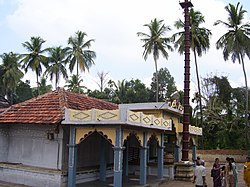메시에 9
Messier 9| 메시에 9 | |
|---|---|
 메시에 9 by HST | |
| 관측 데이터(J2000 epoch) | |
| 클래스 | 8세[1] |
| 별자리 | 오푸치우스 |
| 우측 상승 | 17h 19m 11.78s[2] |
| 탈위임 | –18° 30′ 58.5″[2] |
| 거리 | 25.8kly(7.9kpc)[3] |
| 겉보기 크기 (V) | +7.9[4] |
| 외관 치수(V) | 9.3′[4] |
| 물리적 특성 | |
| 미사 | 4.22×105[3] M☉ |
| 반지름 | 리로45리[3] |
| 금속성 | / = –1.77[3] 덱스 |
| 추정연령 | 12.0 Gyr[5] |
| 기타 지정 | HD 156587, NGC 6333[6] |
메시에 9 또는 M9(또한 NGC 6333으로 지정됨)는 Ophiuchus 별자리에 있는 구상 성단이다. 그것은 에타 오피우치의 남서쪽 별자리의 남쪽에 위치하며, 바르나드 64로 명명된 어두운 먼지 구름 위에 놓여 있다.[4][7] 이 성단은 1764년 6월 3일 프랑스의 천문학자 찰스 메시에에 의해 발견되었는데, 그는 이 성단을 "별이 없는 네불라"[8]라고 묘사했다. 1783년 영국의 천문학자 윌리엄 허셜은 그의 반사경을 이용하여 성단 내의 개별 별을 분해할 수 있었다. 그는 성단의 지름이 7~8㎝로 추정했으며 중심 부근에는 별이 빽빽하게 들어차 있었다.[9]
M9의 겉보기 크기는 7.9, 각도 크기는 9.3㎝로 작은 망원경으로 볼 수 있다.[4] 은하 중심부에서 약 5,500광년 떨어져 있는 은하 중심부에 더 가까운 구상 성단 중 하나이다. 지구로부터의 거리는 25,800광년이다.
이 성단의 총 광도는 태양의 약 120,000배, 절대 크기는 -8.04이다. M9에서 가장 밝은 개별 별은 겉보기 등급 13.5로 적당한 크기의 망원경으로 볼 수 있다. M9:21 RR Lyra 변수에서 24개의 변수 별과 더불어 장기 변수인 타입 II 세페이드, 에클립싱 이진수에서 발견되었다. 블루 스트래글러나 SX 페니키스 변수는 아직 발견되지 않았다. 이 군집은 RR Lyr 변수의 기간에 기초하여 Oosterhoff 타입 II 구상체로 분류되며, 이는 은하 외 원점을 배제한다.[10]
약 80'에 (M9의 북동쪽에 있는 1+1⁄3 도)는 조광기 구상성단 NGC 6356이고, 남동쪽에도 거의 같은 것이 구상성단 NGC 6342이다.
갤러리
메시에 9, 2MASS부터
참조
- ^ Shapley, Harlow; Sawyer, Helen B. (August 1927), "A Classification of Globular Clusters", Harvard College Observatory Bulletin, 849 (849): 11–14, Bibcode:1927BHarO.849...11S.
- ^ a b Formiggini, Liliana; et al. (May 2002), "Hidden subluminous stars among the FAUST UV sources towards Ophiuchus", Monthly Notices of the Royal Astronomical Society, 332 (2): 441–455, arXiv:astro-ph/0210325, Bibcode:2002MNRAS.332..441F, doi:10.1046/j.1365-8711.2002.05327.x.
- ^ a b c d Boyles, J.; et al. (November 2011), "Young Radio Pulsars in Galactic Globular Clusters", The Astrophysical Journal, 742 (1): 51, arXiv:1108.4402, Bibcode:2011ApJ...742...51B, doi:10.1088/0004-637X/742/1/51.
- ^ a b c d Gilmour, Jess K. (2012), The Practical Astronomer's Deep-sky Companion, The Patrick Moore Practical Astronomy Series, Springer Science & Business Media, p. 75, ISBN 978-1447100713.
- ^ Koleva, M.; et al. (April 2008), "Spectroscopic ages and metallicities of stellar populations: validation of full spectrum fitting", Monthly Notices of the Royal Astronomical Society, 385 (4): 1998–2010, arXiv:0801.0871, Bibcode:2008MNRAS.385.1998K, doi:10.1111/j.1365-2966.2008.12908.x
- ^ "M 9". SIMBAD. Centre de données astronomiques de Strasbourg. Retrieved 2006-11-15.
- ^ O'Meara, Stephen James (2014), Deep-Sky Companions: The Messier Objects, Cambridge University Press, p. 71, ISBN 978-1107018372.
- ^ Machholz, Don (2002), The Observing Guide to the Messier Marathon: A Handbook and Atlas, Cambridge University Press, p. 23, ISBN 978-0521803861.
- ^ Klein, Hermann Joseph (1901), Star Atlas, Society for promoting Christian knowledge, p. 55.
- ^ Arellano Ferro, A.; et al. (September 2013), "A detailed census of variable stars in the globular cluster NGC 6333 (M9) from CCD differential photometry", Monthly Notices of the Royal Astronomical Society, 434 (2): 1220–1238, arXiv:1306.3206, Bibcode:2013MNRAS.434.1220A, doi:10.1093/mnras/stt1080.
외부 링크
| 위키미디어 커먼즈에는 메시에 9와 관련된 미디어가 있다. |
- 메시에 9 SED 메시에 페이지
- M9, 은하 입상 클러스터 데이터베이스 페이지
- 2012년 3월 16일 메시에 9의 반짝반짝 빛나는 별들, TG데일리 Tg Daily Staff, TG데일리
- NASA 천문학 사진: 메서 9 클로즈업(2012년 3월 23일)
- 위키스키의 메시에 9: DSS2, SDSS, GALEX, IRAS, 수소 α, X선, 아스트로포토, 스카이맵, 기사 및 이미지
![{\displaystyle {\begin{smallmatrix}\left[{\ce {Fe}}/{\ce {H}}\right]\end{smallmatrix}}}](https://wikimedia.org/api/rest_v1/media/math/render/svg/4c0821bd80891e071c08e7c7ee8e022baedf522c)





